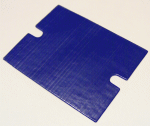
 |
 |
Between the solid state relay and the heat sink surface, you should apply a thermal transfer compound -- commonly referred to as a thermal pad, thermal grease, Dow Corning 340, Silver Artic, or equivalent. The purpose of this compound is to improve the heat transfer capability between the two surfaces. Using too much, too little, or too inconsistent of an amount will reduce the thermal transfer process. Also, using any adhesives will degrade the thermal transfer process. The ideal application is the smallest amount of compound that provides 100% coverage of the entire mating area between the solid state relay and the heat sink with no voids, air gaps, build-up, or run-out. |
|
Power-io provides an optimized dry thermal pad. This pad is black in color and is die-cut for use with solid state relays or our C Family solid state contactors. It consists of a 0.002 aluminum surface (aluminum is an excellent thermal conductor) covered with a 0.00045 layer of dry thermal transfer material of each side. This phase change material will soften when exposed to the solid state relay's heat and it will have a 15% thermal expansion. The softened thermal pad can be easily removed if a solid state relay is replaced at an installation site. A new thermal pad should always be used when a relay is replaced. The thermal impedance is rated at 0.009 °C-in²/W at 80psi, ASTM D5470 mounting pressure (or 0.058 °C-cm²/W at 551.6 KPa, ASTM D5470). The "very low °C-in²/W at high installation pressure" is the best thermal transfer pad that Power-io is aware of for use with our products. The thermal pad is slightly larger than a standard Power-io solid state relay, which is 2.25 inches high by 1.75 inches wide. For purchasing the thermal pad, please visit the accessories page at: http://www.power-io.com/products/heatsinks.htm |
|